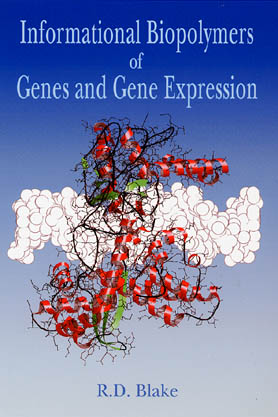
Informational Biopolymers of Genes and Gene Expression
Full of novel insights informed by years of research and teaching, R.D. Blake has written a new text that examines the biophysics and biochemistry of nucleic acids and proteins. This book carves out the dynamic interface between chemistry and molecular biology, and provides a detailed picture of nucleic acids and proteins, their structures, biological properties, and origins and evolution
Summary
Full of novel insights informed by years of research and teaching, R.D. Blake has written a new text that examines the biophysics and biochemistry of nucleic acids and proteins. This book carves out the dynamic interface between chemistry and molecular biology, and provides a detailed picture of nucleic acids and proteins, their structures, biological properties, and origins and evolution. While pitched at a level that is accessible to upper-level undergraduate students of biology, the book will likewise be of keen interest to researchers and graduate students in biology, chemistry and the physical sciences. A broad range of topics accompanied with extensive references, footnotes, boxed asides, chapter ending problems, and detailed illustrations throughout combine to make this an ideal choice for courses on advanced biochemistry, physical biochemistry, nucleic acids and proteins, biophysics and biochemistry, molecular evolution, and protein-nucleic acid interactions.
Resources
Table of Contents
Chapter 1: Introduction to the Informational Biopolymers.
1.1 Proteins.
1.2 Nucleic Acids.
1.3 The Roles of the Informational Biopolymers in the Dissemination of Genetic Information.
1.4 The Cellular Imperative.
Chapter 2: Forces Within and Between Biopolymers.
2.1 Conformational Potential Energy.
2.2 Dispersion and Exclusion Effects.
2.3 Ionic Interactions.
2.4 Dipole Interactions.
2.5 van der Waals Forces.
2.6 Hydrogen Bonds.
2.7 Hydrophobic Bonds.
2.8 Stacking Interactions.
2.9 Modeling Structures by Computational Molecular Mechanics.
Chapter 3: Proteins.
3.1 Amino Acids
3.2 The Peptide Backbone.
3.3 Secondary Structures..
3.4 Thermodynamics of the a-Helix.
3.5 Tertiary and Quaternary Structures.
3.6 Protein Folding.
3.7 Evolutionary Relationships from Primary Sequences.
Chapter 4: Covalent Features of the Nucleic Acids.
4.1 Nucleotide Sugar
4.2 Nucleotide Base.
4.3 The N-Glycosidic Bond.
4.4 Phosphoester Bond.
4.5 Pyrimidine and Nucleotide Cofactors
Chapter 5: Structure, Synthesis and Function of RNA
5.1 The Preponderance of Ribosomal, Transfer, and Small Nuclear RNA in Cells.
5.2 Primary Structures of RNA
5.3 Secondary Structures of RNAs.
5.4 Tertiary Structures of RNAs.
5.5 Protein-RNA Interactions.
5.6 The Biosynthesis of RNAs: Transcription.
5.7 The Participation of RNAs in Protein Synthesis.
Chapter 6: Secondary Structure of Duplex DNA.
6.1 Contributions of Fiber Diffraction to Our Knowledge of DNA Structure.
6.2 Prelude to the Watson-Crick Douuble Helix.
6.3 Refined and Archetypal Structures.
6.4 Structural Features Common to All Nucleic Acid Helices.
6.5 Structures From Single-Crystal Diffraction Analysis.
6.6 Structure in Solutions.
6.7 Hydrogen Bonding in an Aqueous Environment.
6.8 Molecular Dynamics of DNA.
6.9 Denaturation and the Thermodynamics of DNA Stability.
6.10 Higher Organization of DNA.
6.11 Macromolecular Structure.
Chapter 7: Primary Sequences of DNA.
7.1 Base Compositions of Prokaryotic DNAs
7.2 Base Compositions of Eukaryotic DNAs.
7.3 Dinucleotide (Nearest Neighbor) Frequencies
7.4 Sequence Complexity.
7.5 Primary Sequences in Prokaryotes.
7.6 Primary Sequence Elements in Eukaryotes.
7.7 Satellite DNA and Repetitive Sequences.
7.8 Primary Sequences of Mitochondrial DNA.
7.9 Determining Evolutionary Relationships from Primary Sequences.
Chapter 8: Interactions of Water and Cations With DNA, Integral Components of the Native Conformation.
8.1 The Unusual Character of Water.
8.2 Hydration of Electrolytes.
8.3 Interactions of Hydrated Ions in Solution
8.4 Macroscopic Studies of DNA Hydration.
8.5 Microscopic Studies of DNA Hydration. Single Crystal Diffraction.
8.6 Interactions of Cations with DNA.
Chapter 9: Structures and Functional Interactions of Proteins with DNA.
9.1 Modes of Interaction.
9.2 Methods of Analysis.
9.3 Principles of Sequence-Specific DNA Binding Proteins.
9.4 DNA-Binding Proteins of the Structural Class.
9.5 DNA-Binding Proteins of the Enzymatic Class.
9.6 DNA-Binding Proteins of the Regulatory Class.
Chapter 10. Cellular Replication of DNA.
10.1 Stages of Replication.
10.2 Origin Locus of Replication.
10.3 Condensation of dNTP and Elongation of DNA.
10.4 Auxiliary Replicative Processes.
10.5 Replication of the Ends of Linear Eukaryotic DNA by Telomerase.
Chapter 11: Mutations and Unscheduled Decay, Reactivity and Interactions of DNA.
11.1 Mutations.
11.2 Point Mutations.
11.3 Relative Rates of Point Mutation
11.4 Molecular Basis of Mutagenesis.
11.5 Reactions with Endogenous Agents.
11.6 Reactions of Exogenous Agents with DNA.
Chapter 12: Repair and Recombination of DNA.
12.1 Enzymes that Serve Several Functional Roles Including Repair.
12.2 Multiple Pathways for the Repair of Damage Caused by UV Radiation.
12.3 Mismatch Repair.
12.4 Excision Repair.
12.5 Direct Reversal of Certain Lesions.
12.6 The SOS Repair System.
12.7 Recombination and Recombination Repair.
Chapter 13: Prebiotic Origins.
13.1 The Physical Age of the Universe.
13.2 Formation of Earth.
13.3 Age of Chemistry.
13.4 Thermodynamic Precepts for Origins and Order. Dissipative Processes.
13.5 Hypercycles.
13.6 Age of Abiotic Chemistry, Synthesis of Alpha and Beta Molecules.
13.7 Synthesis of Gamma Monomeric Units of D-Ribose by Abiotic Means.
13.8 Beta Monomeric Units of Ribose Analogs.
13.9 The Age of Prebiotic Chemistry.
13.10 The RNA World.
Reviews
“Written in a detailed but very accessible way, Blake’s book plays down the use of equations and formalisms so they don’t get in the way of the narrative flow of ideas and concepts. The comprehensive array of topics makes it very attractive as both a reference text and a textbook for Physical Biochemistry or Molecular Biology courses. It fills a real unmet need by looking at a whole range of fashionable molecular biology topics with a rigor that has never before been applied to these topics in one volume.”
– Ken Marx, University of Massachusetts
“I am blown away by this book: its scope, its level of detail, its up-to-date coverage. It will be a valuable source to have on one’s shelf to refer to a concise discussion of a topic, with lots of references to the pertinent literature.”
– Victor Bloomfield, University of Minnesota
“Without doubt, this book will make a useful reference text for the expert and should provide a good text for teaching graduate students.”
– Philip C. Bevilacqua, University of Pennsylvania
